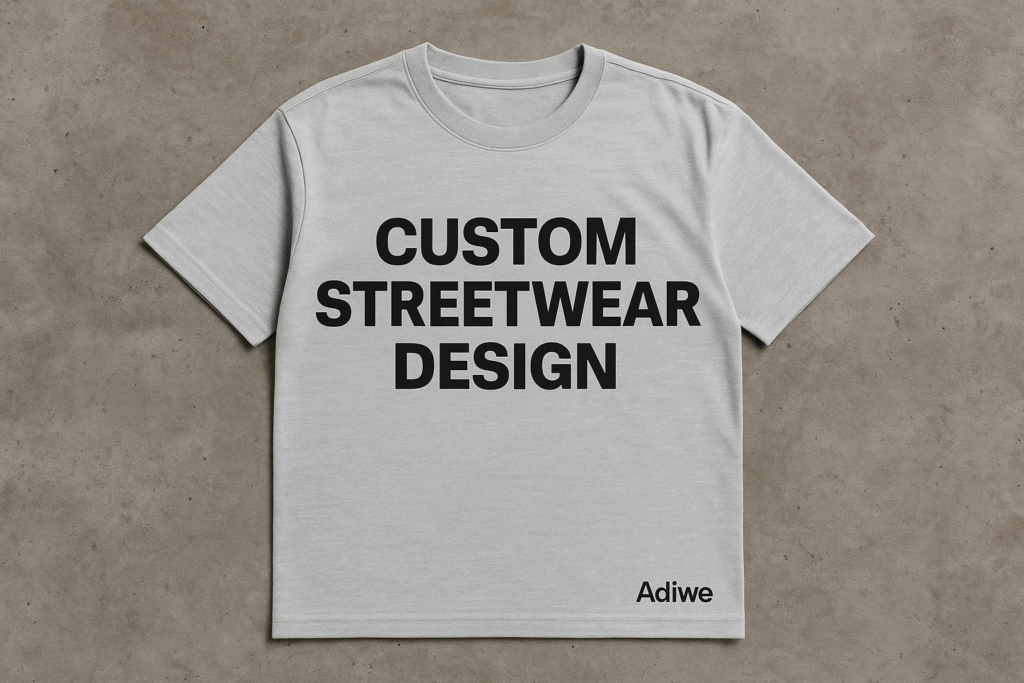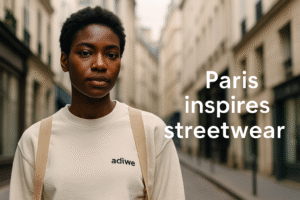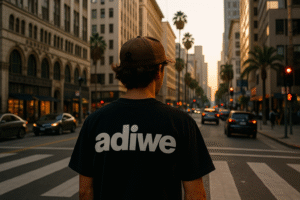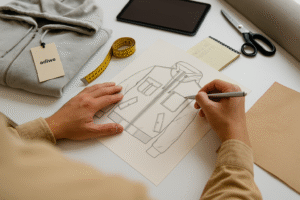Dreaming of custom streetwear but worried about missteps? Many brands stumble, wasting time and money. I'll guide you past common pitfalls for a successful collection.
Key mistakes include ignoring your target audience, skimping on quality, overcomplicating designs, neglecting branding, and underestimating production. Avoiding these ensures your custom streetwear resonates and sells.
Creating custom streetwear is an exciting venture. It allows your brand to express its unique vision and offer something truly special to your customers. I've worked with many clients, from emerging trend brands to established names like Fifty Fifty in England, and I've seen firsthand what works and what doesn't. It's not just about a cool graphic on a t-shirt or hoodie; it's about a thoughtful process. Avoiding common errors can make the difference between a sell-out collection and a garage full of unsold inventory. Let's explore these mistakes so you can steer clear of them.
Mistake 1: Are You Ignoring Your Target Audience?
You've got a killer design idea, but who is it actually for? Designing in a vacuum is risky; your masterpiece might not connect with the people you want to reach.
A huge mistake is designing custom streetwear without a clear customer in mind. Your pieces must align with your target audience's specific style preferences, values, and what they genuinely want to wear.
!
One of the first questions I ask my clients at Adiwe is, "Who are you designing this for?" Without a clear answer, it's like shooting arrows in the dark. Your custom streetwear needs to speak directly to a specific group. For example, the hoodies we produce for Fifty Fifty are designed with their young, trend-conscious UK customers in mind. They know what details, fits, and aesthetics will appeal to that demographic. If you design something that you think is cool but doesn't resonate with your intended buyers, you'll struggle.
Why Knowing Your Audience is Crucial
Understanding your audience influences every decision. It guides your choice of garments (t-shirts, hoodies, jackets), fits (oversized, slim), color palettes, graphic styles, and even the price point. If your audience values sustainability, then eco-friendly materials become a priority. If they are into a specific subculture, your designs should reflect that authentically.
How to Define Your Target Streetwear Customer
You need to go beyond basic demographics. Think about their lifestyle, their inspirations, other brands they like, and where they hang out online and offline. Create customer personas.
| Aspect | Question to Ask Yourself | Example: Young Urban Creative |
|---|---|---|
| Demographics | Age, location, gender, occupation? | 18-28, city-dweller, student/freelancer |
| Psychographics | Values, interests, lifestyle, opinions? | Values self-expression, art, music, community |
| Style | Preferred aesthetics, fits, brands? | Minimalist with bold graphics, comfortable fits |
| Pain Points | What are they looking for that's missing? | Unique pieces, not mass-produced, good quality |
Knowing this helps us at Adiwe advise on fabric choices and customization options that will hit the mark.
Mistake 2: Are You Skimping on Quality for Cost Savings?
Tempted to use cheaper materials or cut corners in manufacturing to save a few bucks? This can severely damage your brand's reputation, especially when "custom" implies something special.
Sacrificing material and construction quality to lower costs is a critical error. Custom streetwear inherently suggests higher value; poor quality betrays customer trust and leads to dissatisfaction and negative reviews.

I always emphasize to my clients that quality is non-negotiable, particularly for custom pieces. Your customers, especially those seeking unique streetwear, have a keen eye for detail. They can feel the difference between a premium, well-constructed hoodie and one made with flimsy fabric and sloppy stitching. Offering top quality is a core feature of our products at Adiwe. If a custom item feels cheap, it undermines the "custom" aspect and makes your brand look bad. This is a lesson many brands learn the hard way.
The True Cost of Low Quality
While you might save money initially, low quality leads to long-term costs. These include returns, negative word-of-mouth, damaged brand reputation, and lost future sales. Customers who pay a premium for custom items expect them to last. If a t-shirt shrinks drastically after one wash or a print cracks easily, they won't come back.
Balancing Cost and Premium Feel
It's about smart choices, not just cheap ones. We can achieve a premium feel without always using the most expensive option.
| Quality Aspect | Low-Cost Approach (Risky) | Smart Quality Approach | Impact on Brand |
|---|---|---|---|
| Fabric | Thin, basic cotton blend | Mid-weight, soft-touch combed cotton | Perceived as cheap vs. Good value |
| Construction | Single stitching, loose threads | Reinforced seams, clean finishing | Looks unprofessional vs. Durable |
| Print/Embroidery | Fades/cracks quickly, rough feel | Durable techniques, good hand-feel | Disappointing vs. Impressive |
| Hardware | Flimsy zippers, cheap buttons | Sturdy, well-finished custom options | Frustrating vs. Premium feel |
As a factory, we guide clients on how to get the best quality within their budget by choosing the right customizable fabrics and craftsmanship techniques.
Mistake 3: Are You Overcomplicating Designs Unnecessarily?
Is your design trying to say too much at once, a jumble of logos, graphics, and text? Sometimes, simplicity is more powerful in streetwear. Achieving a strong impact often means editing down.
Trying to cram too many trends, colors, or graphic elements into a single custom streetwear design often makes it look cluttered and unfocused. Effective pieces usually have a clear, cohesive aesthetic.

I've seen designs come across my desk that look like every single idea the client had was thrown onto one garment. While creativity is key, so is restraint. Streetwear often thrives on bold, singular statements. Think of iconic pieces – they usually have one or two strong focal points. An overly complicated design can confuse the eye and dilute the message. My client Fifty Fifty, for instance, often opts for strong graphic placements on their hoodies, but they ensure the overall design remains clean and impactful, which is very trendy.
The Power of Simplicity and Focus
A well-edited design allows key elements to shine. It's easier for the customer to understand and appreciate. Simplicity doesn't mean boring; it means intentional. A single, well-executed graphic or a unique silhouette can be far more powerful than a garment overloaded with details.
Editing Your Design Ideas
Ask yourself: Does every element serve a purpose? Does it contribute to the overall story or aesthetic? If not, consider removing it.
| Design Aspect | Overcomplicated Approach | Focused & Impactful Approach | Customer Reaction |
|---|---|---|---|
| Graphics | Multiple competing images, styles, fonts | One strong central graphic or subtle pattern | Confusing, overwhelming |
| Colors | Too many clashing colors | A well-chosen, harmonious color palette | Hard to look at, dated |
| Placement | Graphics everywhere (front, back, sleeves) | Strategic placement for maximum impact | "Trying too hard" |
| Branding | Large, obvious logos in multiple places | Subtle, clever branding or one statement logo | Looks cheap, billboard-like |
We often help clients refine their designs at Adiwe, suggesting ways to simplify for better production outcomes and stronger visual appeal, especially when complex craftsmanship is involved.
Mistake 4: Are You Neglecting Branding and Storytelling?
Your custom streetwear might look technically good, but does it have a soul? If it doesn't tell a story or connect to a clear brand identity, it risks being just another generic garment.
Custom streetwear without a distinct brand identity or compelling narrative is easily forgotten. Strong branding and storytelling transform mere clothing into desirable statements that build a loyal following.

Customers, especially in the streetwear space, buy into more than just fabric and thread; they buy into an identity, a community, a story. If your custom pieces don't reflect who your brand is and what it stands for, you're missing a huge opportunity. I always encourage brands to think about the 'why' behind their designs. What message are you sending? What makes your brand different? This is crucial for clothing brands and KOLs who want to build a personal connection.
Building a Brand Beyond the Garment
Your brand is the sum of all experiences someone has with you. This includes your logo, color scheme, tone of voice, and the values you project. Custom streetwear should be a physical manifestation of this brand identity.
Weaving Your Story into Custom Pieces
Every design can tell a part of your brand's story. This could be through:
- Inspiration: What inspired this specific design or collection?
- Symbolism: Do certain graphics or colors have a deeper meaning for your brand?
- Messaging: Are there slogans or text elements that convey your brand's ethos?
| Element | Generic Approach | Branded/Storytelling Approach | Customer Connection |
|---|---|---|---|
| Logo Usage | Slapped on | Integrated thoughtfully, perhaps subtly | Weak / Stronger |
| Hang Tags | Basic info | Tells brand story, material origin, care | Informative / Engaging |
| Design Theme | Random graphics | Cohesive theme linked to brand values/narrative | Forgettable / Memorable |
| Color Palette | Follows fleeting trends | Consistent with brand identity, symbolic choices | Inconsistent / Recognizable |
At Adiwe, we offer personalized design options, including custom labels and accessories, that help brands reinforce their identity and tell their story through the garments themselves.
Mistake 5: Are You Underestimating Production Challenges?
You've designed an incredibly intricate, multi-layered custom piece. It looks amazing on screen, but have you thought about how it will actually be made? Ignoring manufacturing realities can lead to major headaches.
Not considering the practicalities of manufacturing during the design phase is a common and costly mistake. Complex designs may be unproducible within budget, face quality issues, or simply be too difficult for factories to execute accurately.

This is where my experience as a factory owner really comes into play. I often see ambitious designs from new brands that, while creative, are incredibly challenging or expensive to produce. For example, a hoodie with ten different embroidery placements, unique paneling, custom-dyed fabrics, and bespoke hardware might look incredible, but the cost and time involved in production could be prohibitive, especially for smaller runs. Fifty Fifty, for instance, knows their designs can be complex and require a lot of craftsmanship, so they communicate closely with us from the start to ensure feasibility.
Designing for Manufacturability (DFM)
This means designing with production in mind. Consider:
- Complexity vs. Cost: More complex designs usually mean higher labor costs and potentially higher minimum order quantities for certain techniques.
- Material Sourcing: Are the specified materials readily available, or do they need to be custom-developed, adding time and cost?
- Technique Limitations: Some print or embroidery techniques work better on certain fabrics or placements.
Clear Communication with Your Factory
A good manufacturing partner will provide feedback on your designs.
| Design Aspect | Potential Production Issue | Solution / Consideration | Outcome if Ignored |
|---|---|---|---|
| Intricate Embroidery | High stitch count, Puckering | Simplify, test on fabric, adjust backing | Poor quality, high cost |
| All-Over Prints | Registration issues, seam mismatch | Panel printing, realistic expectations | Misaligned, unprofessional |
| Custom Dyeing | Color matching, minimums | Lab dips, realistic timelines, stock colors | Delays, incorrect colors |
| Unique Silhouettes | Pattern making complexity, fit issues | Prototyping, clear tech packs, skilled pattern maker | Poor fit, high waste |
As a factory with 5 production lines, Adiwe is used to handling diverse and personalized designs, but open dialogue about design feasibility early on saves everyone time and ensures the final product meets expectations in terms of quality and trendiness.
Conclusion
Avoiding these common mistakes will set your custom streetwear brand up for success. Focus on your audience, quality, clear design, strong branding, and practical production for truly impactful pieces.




